Refine search
Actions for selected content:
10306 results in History of science: general interest
Alexander Marr (ed.), The Worlds of Oronce Fine: Mathematics, Instruments and Print in Renaissance France. Donington: Shaun Tyas, 2009. Pp. xv+224. ISBN 978-1-900289-96-2. £40.00 (hardback).
-
- Journal:
- The British Journal for the History of Science / Volume 44 / Issue 3 / September 2011
- Published online by Cambridge University Press:
- 08 September 2011, pp. 461-462
- Print publication:
- September 2011
-
- Article
- Export citation
BJH volume 44 issue 3 Cover and Front matter
-
- Journal:
- The British Journal for the History of Science / Volume 44 / Issue 3 / September 2011
- Published online by Cambridge University Press:
- 08 September 2011, pp. f1-f2
- Print publication:
- September 2011
-
- Article
-
- You have access
- Export citation
Helmuth Trischler and Mark Walker (eds.), Physics and Politics: Research Support in Twentieth Century Germany in International Perspective. Stuttgart: Franz Steiner Verlag, 2010. Pp. 285. ISBN 978-3-515-09601-0. €44.00 (paperback).
-
- Journal:
- The British Journal for the History of Science / Volume 44 / Issue 3 / September 2011
- Published online by Cambridge University Press:
- 08 September 2011, pp. 470-472
- Print publication:
- September 2011
-
- Article
- Export citation
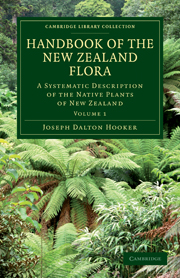
Handbook of the New Zealand Flora
- A Systematic Description of the Native Plants of New Zealand and the Chatham, Kermadec's, Lord Auckland's, Campbell's, and Macquarrie's Islands
-
- Published online:
- 05 August 2011
- Print publication:
- 18 April 2011
- First published in:
- 1864

Geological Observations on the Volcanic Islands, Visited During the Voyage of HMS Beagle
- Together with Some Brief Notices on the Geology of Australia and the Cape of Good Hope
-
- Published online:
- 05 August 2011
- Print publication:
- 02 June 2011
- First published in:
- 1844
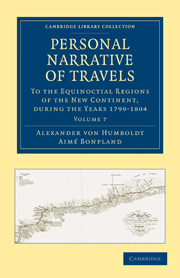
Personal Narrative of Travels to the Equinoctial Regions of the New Continent
- During the Years 1799–1804
-
- Published online:
- 05 August 2011
- Print publication:
- 02 June 2011
- First published in:
- 1829
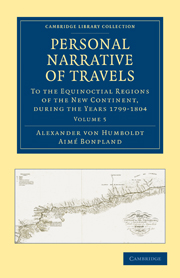
Personal Narrative of Travels to the Equinoctial Regions of the New Continent
- During the Years 1799–1804
-
- Published online:
- 05 August 2011
- Print publication:
- 02 June 2011
- First published in:
- 1821
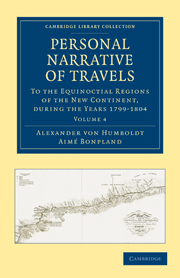
Personal Narrative of Travels to the Equinoctial Regions of the New Continent
- During the Years 1799–1804
-
- Published online:
- 05 August 2011
- Print publication:
- 02 June 2011
- First published in:
- 1819
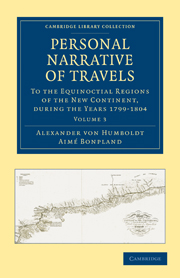
Personal Narrative of Travels to the Equinoctial Regions of the New Continent
- During the Years 1799–1804
-
- Published online:
- 05 August 2011
- Print publication:
- 02 June 2011
- First published in:
- 1818
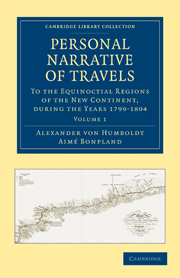
Personal Narrative of Travels to the Equinoctial Regions of the New Continent
- During the Years 1799–1804
-
- Published online:
- 05 August 2011
- Print publication:
- 02 June 2011
- First published in:
- 1814

A History of the Royal Society
- With Memoirs of the Presidents
-
- Published online:
- 05 August 2011
- Print publication:
- 19 May 2011
- First published in:
- 1848
‘Stargazers at the world's end’: telescopes, observatories and ‘views’ of empire in the nineteenth-century British Empire
-
- Journal:
- The British Journal for the History of Science / Volume 46 / Issue 3 / September 2013
- Published online by Cambridge University Press:
- 03 August 2011, pp. 389-413
- Print publication:
- September 2013
-
- Article
- Export citation
Making biomedicine in twentieth-century Italy: Domenico Marotta (1886–1974) and the Italian Higher Institute of Health
-
- Journal:
- The British Journal for the History of Science / Volume 44 / Issue 4 / December 2011
- Published online by Cambridge University Press:
- 03 August 2011, pp. 549-574
- Print publication:
- December 2011
-
- Article
- Export citation
Preaching at the British Association for the Advancement of Science: sermons, secularization and the rhetoric of conflict in the 1870s
-
- Journal:
- The British Journal for the History of Science / Volume 45 / Issue 1 / March 2012
- Published online by Cambridge University Press:
- 27 July 2011, pp. 75-95
- Print publication:
- March 2012
-
- Article
- Export citation
The social nature of the mother's tie to her child: John Bowlby's theory of attachment in post-war America
-
- Journal:
- The British Journal for the History of Science / Volume 44 / Issue 3 / September 2011
- Published online by Cambridge University Press:
- 06 June 2011, pp. 401-426
- Print publication:
- September 2011
-
- Article
- Export citation
Kristian Camilleri, Heisenberg and the Interpretation of Quantum Mechanics: The Physicist as Philosopher. Cambridge: Cambridge University Press, 2009. Pp. xii+199. ISBN 978-0-521-88484-6. £45.00 (hardback). - Cathryn Carson, Heisenberg in the Atomic Age: Science and the Public Sphere. Cambridge: Cambridge University Press, 2010. Pp. xxiv+541. ISBN 978-0-521-82170-4. £55.00 (hardback).
-
- Journal:
- The British Journal for the History of Science / Volume 44 / Issue 2 / June 2011
- Published online by Cambridge University Press:
- 27 May 2011, pp. 308-309
- Print publication:
- June 2011
-
- Article
- Export citation
Ian Hesketh, Of Apes and Ancestors: Evolution, Christianity and the Oxford Debate. Toronto: University of Toronto Press, 2009. Pp. viii+144. ISBN 978-0-8020-9284-7. CDN$29.95 (hardback).
-
- Journal:
- The British Journal for the History of Science / Volume 44 / Issue 2 / June 2011
- Published online by Cambridge University Press:
- 27 May 2011, pp. 298-300
- Print publication:
- June 2011
-
- Article
- Export citation
Richard Moore, Nuclear Illusion, Nuclear Reality: Britain, the United States and Nuclear Weapons 1958–64. Basingstoke: Palgrave Macmillan, 2010. Pp. xvi+332. ISBN 978-0-230-23067-5. £65.00 (hardback).
-
- Journal:
- The British Journal for the History of Science / Volume 44 / Issue 2 / June 2011
- Published online by Cambridge University Press:
- 27 May 2011, pp. 309-311
- Print publication:
- June 2011
-
- Article
- Export citation
Florike Egmond, The World of Carolus Clusius: Natural History in the Making 1550–1610. London: Pickering and Chatto, 2010. Pp. xiv+292. ISBN 978-1-84893-008-7. £60.00 (hardback).
-
- Journal:
- The British Journal for the History of Science / Volume 44 / Issue 2 / June 2011
- Published online by Cambridge University Press:
- 27 May 2011, pp. 286-287
- Print publication:
- June 2011
-
- Article
- Export citation
Ole Peter Grell, Andrew Cunningham and Jon Arrizabalaga (eds.), Centres of Medical Excellence? Medical Travel and Education in Europe, 1500–1789. Farnham: Ashgate, 2010. Pp. xvi+335. ISBN 978-0-7546-6699-8. £60.00 (hardback).
-
- Journal:
- The British Journal for the History of Science / Volume 44 / Issue 2 / June 2011
- Published online by Cambridge University Press:
- 27 May 2011, pp. 283-284
- Print publication:
- June 2011
-
- Article
- Export citation
